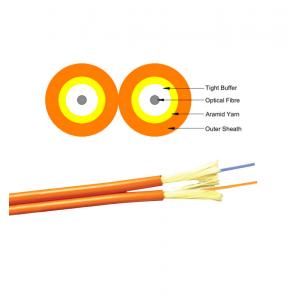
Add to Cart
Indoor Duplex Zipcord Cable
Description
Duplex fibre optic cables used to have two fibres joined together by a thin web or “zipcord” construction. One strand transmitted from point A to point B and the other from B to A. Both ends had a transmitter and a receiver. The emergence of single-strand fibre transmission has changed the situation. It seemed to be a better alternative for network managers, providing an increased network capacity, higher reliability due to fewer connections and overall cost savings. Single-strand duplex fibre transmission uses a single fibre to send data in both directions, namely bidirectional or BiDi transmission. This technology is based on two wavelengths traveling in opposite directions and is achieved by combining and separating data transmitted over a single fibre based on the wavelengths of the lights (typically around 850, 1300 and 1550 nm). Only some equipment manufacturers are using or moving to a single-strand cable for their connectivity, as the equipment becomes very expensive. It exists for certain applications, but it is not the norm.
Features
Temperature Characteristics
1.Operate temperature range: -20oC to +60oC .
2.Storage temperature range: -20oC to +60oC .
Specification
| Zipcord Optical Fiber Cable | ||||
| Outer Diameter (mm) | 1.6x3.3 | 1.8x3.7 | 2.0x4.1 | 2.8*5.7 |
| Normal Weight (kg/km) | 5.7 | 6.7 | 8.2 | 13.2 |
| Long term tensile strength (N) | 80 | 80 | 100 | 160 |
| Short term tensile strength (N) | 160 | 160 | 200 | 300 |
| Minimum Static bending radius | 10H | |||
| Minimum Dynamic bending radius | 20H | |||
| Long term crush resistance (N) | 500 | |||
| Short term crush resistance (N) | 100 | |||